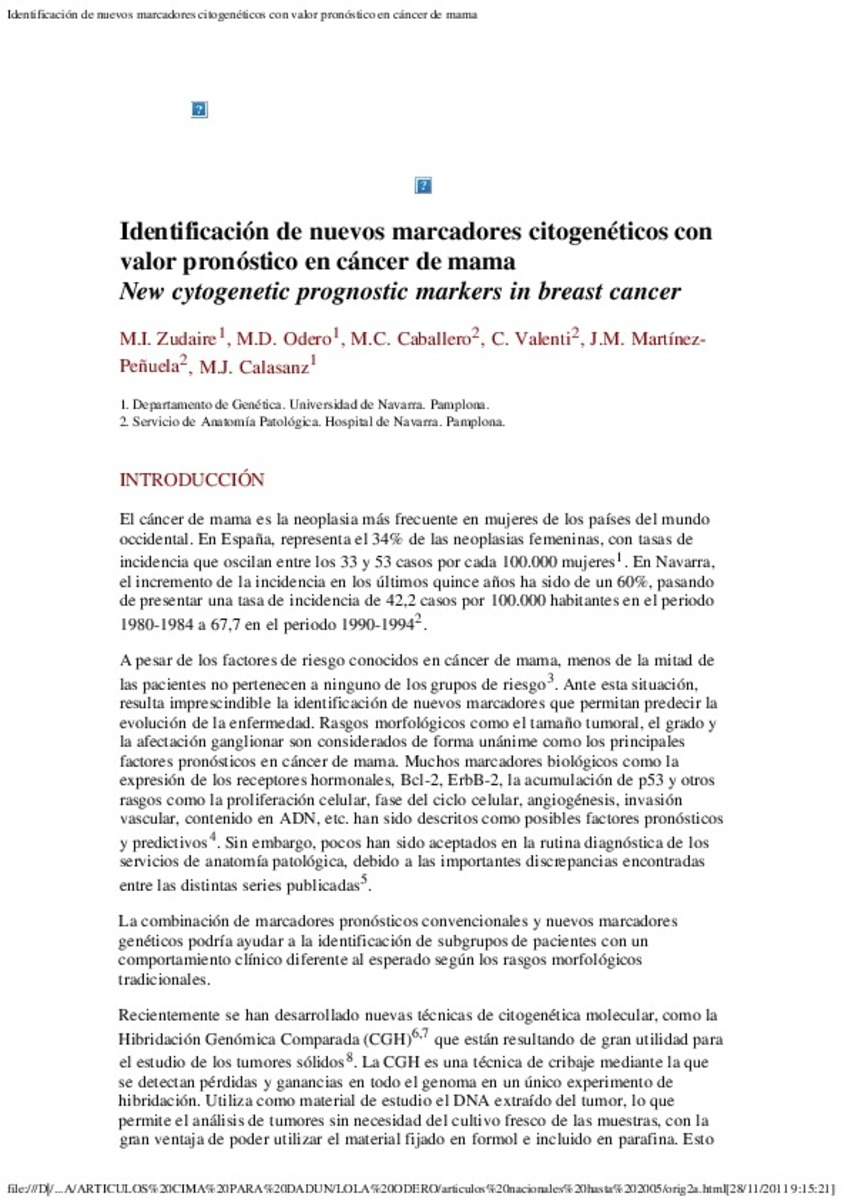Full metadata record
| DC Field | Value | Language |
|---|---|---|
| dc.creator | Zudaire, I. (Isabel) | - |
| dc.creator | Odero, M.D. (Maria Dolores) | - |
| dc.creator | Caballero, M.C. (M.C.) | - |
| dc.creator | Valenti, C. (C.) | - |
| dc.creator | Martinez-Peñuela, J.M. (J.M.) | - |
| dc.creator | Calasanz-Abinzano, M.J. (Maria Jose) | - |
| dc.date.accessioned | 2011-11-28T08:20:29Z | - |
| dc.date.available | 2011-11-28T08:20:29Z | - |
| dc.date.issued | 2001 | - |
| dc.identifier.citation | Zudaire MI, Odero MD, Caballero MC, Valenti C, Martinez-Penuela JM, Calasanz MJ. New cytogenetic prognostic markers in breast cancer. An Sist Sanit Navar 2001 Jan-Apr;24(1):25-37. | es_ES |
| dc.identifier.issn | 1137-6627 | - |
| dc.identifier.uri | https://hdl.handle.net/10171/19949 | - |
| dc.description.abstract | Abstract BACKGROUND: The aim of this study was to identify chromosomal imbalances in a series of invasive ductal carcinomas. In order to characterize the prognostic value of the chromosomal aberrations, we determined the association between genetic changes, overall survival, recurrences and some well-known prognostic and diagnostic parameters. MATERIAL AND METHODS: We included in this study 70 ductal invasive carcinomas diagnosed at the Hospital of Navarra during 1991-1994. We used the Comparative Genomic Hybridization Technique (CGH) for the molecular cytogenetic analysis of formalin-fixed, paraffin embedded specimens. RESULTS: We obtained successful results in 57 out of 70 cases (81.4%). The most frequent recurring findings were DNA gains on 8q, 17q, 1q, 20q, 11q and 6q and losses on 16q, Xp, Xq, 13q, 11q and 8p. In the survival study, gains on 1q and 11q13 were more frequent in patients with recurrence (41.3% vs. 18.5% and 50% vs. 23.7%). Loss of 16q appears as a prognostic factor of good outcome because of its association with good pathological prognostic features: 100% of tumors with this aberration showed overexpression of Bcl-2, and 75% of them were node negative. Besides, 46.7% of the positive cases for the expression of estrogen receptors also showed this imbalance. CONCLUSIONS: The CGH is a useful technique for the study of paraffin embedded tumors. Our results confirm that the cytogenetic aberrations of tumors could be considered as prognostic factors contributing to a better knowledge of tumor outcome. | es_ES |
| dc.language.iso | spa | es_ES |
| dc.publisher | Gobierno de Navarra. Departamento de Salud | es_ES |
| dc.rights | info:eu-repo/semantics/openAccess | es_ES |
| dc.subject | Breast cancer | es_ES |
| dc.subject | Cytogenetic markers | es_ES |
| dc.title | New cytogenetic prognostic markers in breast cancer | es_ES |
| dc.type | info:eu-repo/semantics/article | es_ES |
| dc.relation.publisherversion | http://www.cfnavarra.es/salud/anales/textos/vol24/n1/orig2i.html | es_ES |
Files in This Item:
Statistics and impact
Items in Dadun are protected by copyright, with all rights reserved, unless otherwise indicated.






